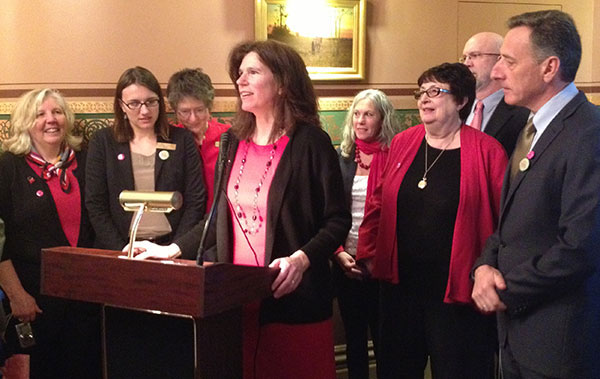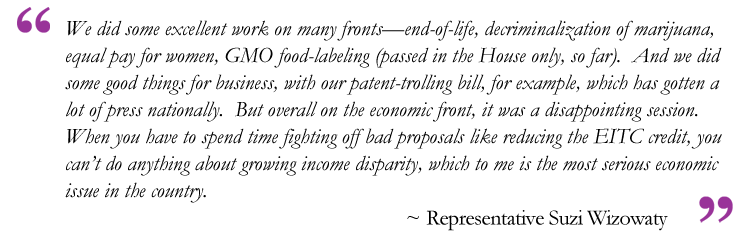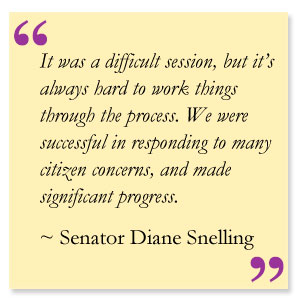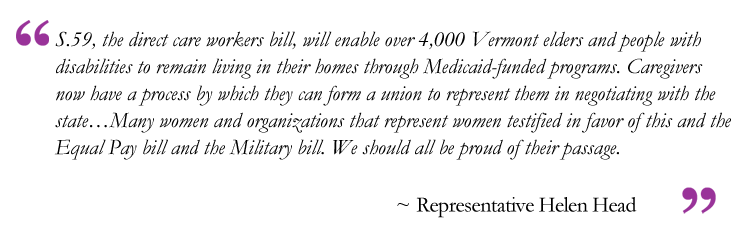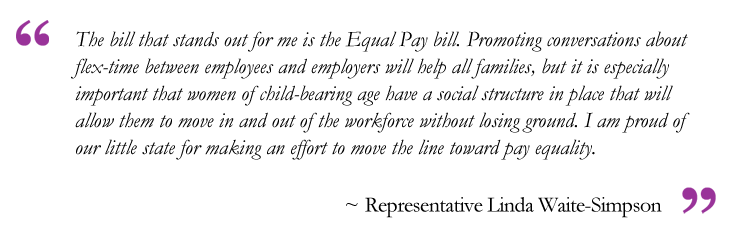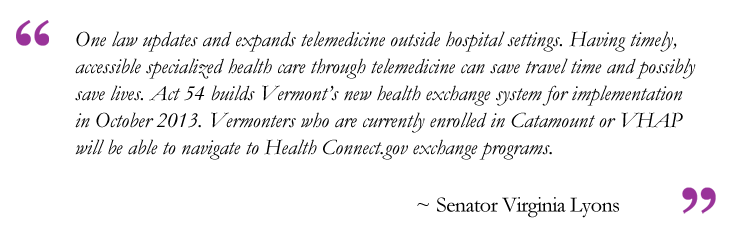The Eyes of Ceres:
Legislative Summary
New Equal Pay Law Shines, but Hard Struggles Overall
|
|||||||
Equal Pay Women's economic equity in Vermont will arguably set a new standard for the country. The passage of Vermont's new Equal Pay law surpasses what the federal government has tried and failed to do with its stalled Paycheck Fairness Act. Vermont also broke ground as the first state in the U.S. to protect a worker's right to ask for flexible hours and working arrangements without retaliation. Over 40 percent of American households are now headed by a woman as the primary breadwinner. Yet the gender wage gap continues to dog women, even in Vermont, where women earn just 87 percent of the income men in Vermont earn overall. The reasons for this gap are complex, and the legislature recognized that fact with the passage of a law that uses multiple approaches to bring equity to working women and to men who take family responsibilities seriously:
Before the passage of S.47 this year, a person who filed a Relief from Abuse Protection Order was the one who was responsible for getting that order to the local sheriff so it could be served. This law takes that responsibility out of the victim's hands, and makes it the court's job to get the order to the sheriff. If the defendant appeals the order, it is no longer automatically put on hold. Both measures provide a greater measure of safety to victims. Additionally, the law now clarifies that if the defendant has the plaintiff's personal documentation (such as a driver's license or birth certificate), the court may order it to be returned. It's not uncommon for an abuser to hold onto such documents to thwart a victim's efforts to seek employment or education, or otherwise seek to control him or her. This law will make it harder to get away with. Statute of limitations on sex crimes extended Previously, Vermont law required prosecution of certain crimes of sexual violence against a child to happen by the time the victim turns 24, or within ten years of the crime, whichever is earlier. This timeframe did not reflect the nature of the crime. Children don't report sexual violence for many reasons, including threats by their abuser, confusion about the nature of the crime; a belief that they will not be believed, or they simply don't remember or understand what happened until well into adulthood. Perpetrators are known to target victims who seem most unlikely to report, and so the old statute of limitations didn't fit the crime. The law passed this year extends the statute of limitations for reporting sexual assault of a child, sexual exploitation of a minor, and lewd or lascivious conduct with a child to 40 years after the crime's occurrence.
Sexual harassment and assault in the Guard A woman serving in the armed forces is more than twice as likely to be sexually assaulted as the rest of the public, and Vermont's legislature took action this year to support efforts to change that. With the passage of a military omnibus bill, the Adjutant General of the Vermont National Guard will now be required to report each year to the legislature the number of incidences of sexual harassment and assault. The report will also include descriptions of current policies and procedures for responding to these crimes. The Vermont National Guard's staffing and practices in their Sexual Assault Prevention and Response Program have increased significantly over the past two years. This reporting requirement will bolster their own efforts and strengthen public accountability. Pre-Kindergarten This year the House passed a comprehensive bill designed to increase Vermont families' access to pre-kindergarten (pre-k) education for their 3- and 4-year-old children. The bill will continue to the Senate next year, where undoubtedly it faces revisions, should that body pass it. The House version builds on the existing structure that provides pre-k education through a blend of public and private programs; these vary, depending on a community's capacity and needs. Currently in 16 percent of Vermont towns, there is no mechanism to pay for any of the eligible children in the town to attend a qualified program. This bill would require those towns to fund at least ten hours of qualified pre-k instruction, through either a public or a private program. It also requires portability of tuition for pre-k education, meaning that if a program doesn't provide necessary wrap-around care or other services, tuition funds may be used to pay for a program that does. The bill does not require that parents enroll their children in pre-k education, but provides them a list of prequalified programs should they choose to, and helps ensure that all families have access to pre-k education.
The House and Senate each passed a bill that would expand the eligibility of children who receive free school meals, while simplifying rules. Currently children whose family incomes are below 130 percent of the federal poverty level qualify for free federally-funded school lunches; children whose family incomes are between 130-185 percent of the federal poverty level qualify to pay a reduced price for their lunch. Many of the children who qualify for reduced-price lunches go without, either because they don't know they're eligible, or because the 40 cents per meal remains too costly for low-income families. The expanded eligibility provides free lunches to all children with family incomes below 185 percent of the federal poverty level, and eliminates the category of reduced price lunch entirely. Harmful chemicals in children's products The legislature acted this year to protect Vermonters from a carcinogenic flame retardant known as chlorinated Tris. Tris was pulled from children's clothing in the 1970s, but is now found in many children's products, including nursing pillows, car seats, and mattresses, and also in some upholstered furniture. It is especially harmful to children, and to firefighters exposed to its release in smoke when burned. Vermont is the first state in the country to pass such a law.
At the beginning of the session, Governor Peter Shumlin's administration put forward a couple of proposals that would have had significant impacts on low-income Vermonters, particularly families headed by single mothers. Vermont's legislature responded in mixed ways. First, the administration proposed implementing a time limit on Reach-Up benefits, which Vermont currently does not impose. The proposal would have meant that a family could receive benefits for three consecutive years; then it would have to be off for one year, and if necessary could again receive them for one more year before having to be off for another year, and then would qualify for one final year before reaching the lifetime cap. Vermont's House and Senate both wrestled with this idea, recognizing that while the vast majority of Reach-Up recipients use the benefits for much less than five years, there are some recipients who face significant barriers to employment, such as lack of child care, transportation, education, or mental health services. These are not currently being adequately addressed by the state's support structures. In the end, the final budget deal implemented a softer version of the administration's proposal, with a five-year cap on benefits but without the required year-long breaks in benefits, and with hardship exemptions that will allow some families to extend beyond the five years. Child-only grants, which go to people taking care of a child who isn't their own, are also exempt from the limit. A legislative working group to assess the program further was established. The Shumlin administration also proposed a plan that would have dramatically increased funding to the Child Care Financial Assistance Program, by diverting $16.7 million from the state's Earned Income Tax Credit (EITC). The legislature soundly rejected this idea, citing the EITC as a vital anti-poverty mechanism for low-income Vermonters that they were unwilling to reduce. The final budget plan provides an additional $1.6 million to the Child Care Financial Assistance Program. Eligibility guidelines, which had been based on the 2010 federal poverty level, have been updated to 2013 poverty levels, and provider rates will increase by three percent. |
|||||||
| Cary Brown is Executive Director of Vermont's Commission on Women. | |||||||

